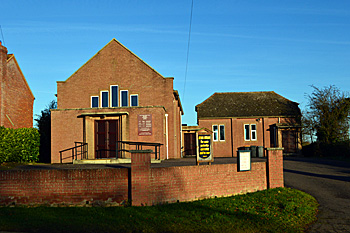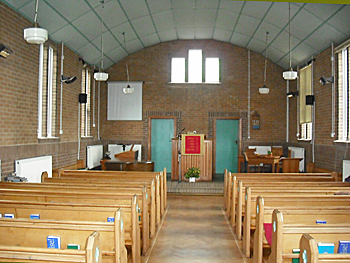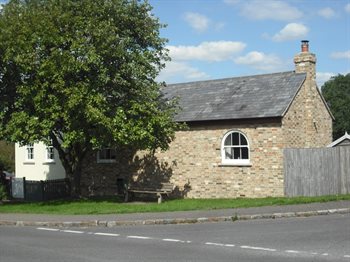Baptists in Little Staughton

Drawing of the old Baptist chapel by Bernard West
This page has been written by Jeanette Atkinson and Brenda Foster
A detailed history of the Little Staughton Meeting and its Pastors was written in 1951 by HG Tibbutt. On 22nd April 1799, the Archdeacon of Bedford granted registration to William Lugsdin, James Lugsdin and James Peppercorn for a large meeting house to be a ‘Place of Religious Worship for Protestant Dissenters’ [ABN2/2]. By 1843 the large meeting house was licensed for marriage (MW Flanders, R Lugsdin, T Slaney).
Eight persons had gathered together and formed the Baptist Church of Little Staughton on 10th June 1766. The eight founders were: William Lugsdin, John Green, George Freshwater, William Grant, Mary Lugsdin, Ann Lugsdin, Ann Emery and Hannah Emery. They covenanted to ‘walk together as a distinct Church of Christ of the Baptist Denomination in all Gospel Ordinances and in all relative duties as the Lord by his Word, Spirit and Providence shall enable us’ [Tibbutt HG, 1951, pages 5-6].
The original Meeting House in Little Staughton was built between 1766 and 1776 and was known as a Protestant Dissenting Meeting House. In April 1776 the Meeting House plus cottages were sold by William Lugsdin to John Emery and ten other members of the congregation for £35. An adjacent burial ground was bought in 1792 for £20 from John Gilbee of Artillery Place, Moorfields, London. A larger building was registered in 1799.
From 1766 to 80 some 158 persons joined the meeting, however discipline was strict and 38 were excluded from membership for one or any of: drunkenness, adultery, Sabbath-breaking, lying, swearing, horse dealing on the Lord’s day, breach of Covenant, defraud or non-attendance.
The Little Staughton Meeting had only six Pastors in 179 years:
- John Emery: 1768 – 1799;
- John Miller: 1801 – 1805;
- James Knight: 1806 – 1837;
- Thomas Robinson: 1836 – 1871;
- Charles Warren: 1872 – 1901;
- Alfred Hall: 1903 – 1947.
It is notable that John Emery (of Bolnhurst) left Little Staughton Meeting firmly established when he died on 13th September 1799. He preached his last on the first of that month; he was 68 years old and was buried in the old chapel.
The Meeting House, later designated as a Baptist Chapel, served a district with the congregation coming from Bedfordshire and Huntingdonshire (Great Staughton, Great Barford, Pertenhall, Kimbolton, Staploe & Wyboston and many other villages and hamlets) hence the need for a 500 seat meeting house. By 1871 the membership stood at 170 with 155 children attending Sunday School. The Chapel was restored in 1878 at a cost of £450; one thousand people attended the service of celebration for the alternations and improvements.
![The Baptist chapel after suffering war damage [Z426/1/36]](/CommunityHistories/Little-Staughton/Little-Staughton-images/The-Baptist-chapel-after-suffering-war-damage-Z426-1-36.jpg)
The Baptist chapel after suffering war damage [Z426/1/36]
The 20th Century saw declining attendance due to the two World Wars and the change in rural life. Finally, in June 1944 the large Meeting House was demolished by the Air Ministry after a Lancaster bomber damaged the roof when taking off on a short runway. As reported in The Bedfordshire Times of June 30th 1944, the last service was held on Sunday 25th June and a Public House (the Bushel and Strike) and two cottages were also demolished alongside the old Chapel Meeting House.

The Baptist chapel January 2017 (Copyright Brenda Foster)
Thereafter services were conducted in the Sunday School building until a new Baptist Chapel was built in 1957 (cost £10,651) using the compensation from the Air Ministry (£10,500). Much smaller (150 seats) plus a school room and further into the centre of the village, this Baptist Church was opened on Thursday April 11th 1957.

The interior of the Baptist chapel March 2017 (Copyright Brenda Foster)
When the new chapel was opened in 1957, Rev. S R Record of Thurleigh had the pastoral oversight of it. Rev Jim Bentley served at the chapel from 1988 then Rev Frank James from April 1991. It is not known how many years these pastors were at the Meeting. Rev Mark Patterson served from October 2003 to June 2005 and Roger Watkins October 2012 to January 2014.
The Sunday School building, used as a shed for the cemetery, fell into disrepair and was derelict by 2011 when it was damaged by a car and became unsafe. It was then sold along with part of the cemetery and developed into a private residence.

The former Sunday School (Copyright Brenda Foster)
The main home for the meeting Pastor, The Manse, was purchased in 1803. It was originally a farmhouse and had a dairy. From 1964 this building was listed; it lies on the Colmworth Road in Little Staughton and is now a private residence.